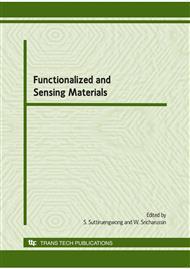p.471
p.475
p.479
p.485
p.489
p.493
p.497
p.501
p.505
Characterization of PVDF-HFP-LiCF3SO3-ZrO2 Nanocomposite Polymer Electrolyte Systems
Abstract:
Nanocomposite polymer electrolytes were prepared by incorporating different amounts of zirconium oxide (ZrO2) nanofiller to poly(vinylidene fluoride-co-hexafluoropropylene)-lithium trifluoromethane sulfonate (PVDF-HFP-LiCF3SO3). X-ray diffraction (XRD) study has been carried out to investigate the structural features of the electrolyte films while a.c. impedance spectroscopy has been performed to investigate their electrical properties. The conductivity of nanocomposite polymer electrolyte systems is influenced by nanofiller concentration. The increase in conductivity is attributable to the increase in the fraction of amorphous region and the number of charge carriers and vice versa. The highest conductivity obtained is in the order of 10-3 S cm-1 for the system dispersed with 5 wt% of ZrO2 nanofiller.
Info:
Periodical:
Pages:
489-492
Citation:
Online since:
January 2010
Keywords:
Price:
Сopyright:
© 2010 Trans Tech Publications Ltd. All Rights Reserved
Share:
Citation:


